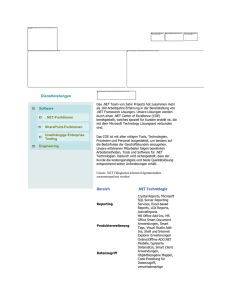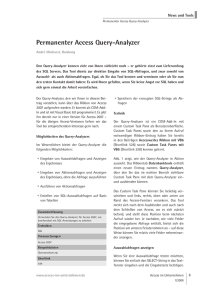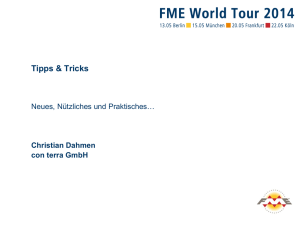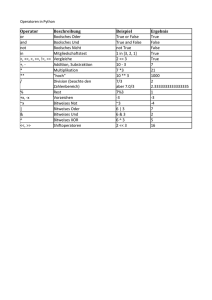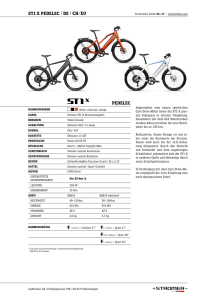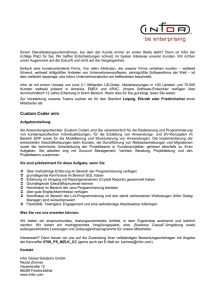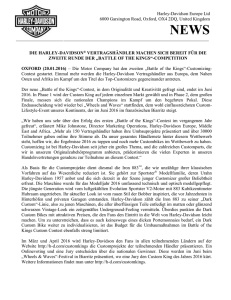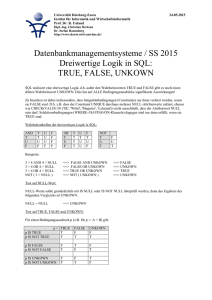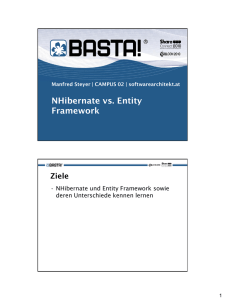Logik und Mengentheorie
Werbung
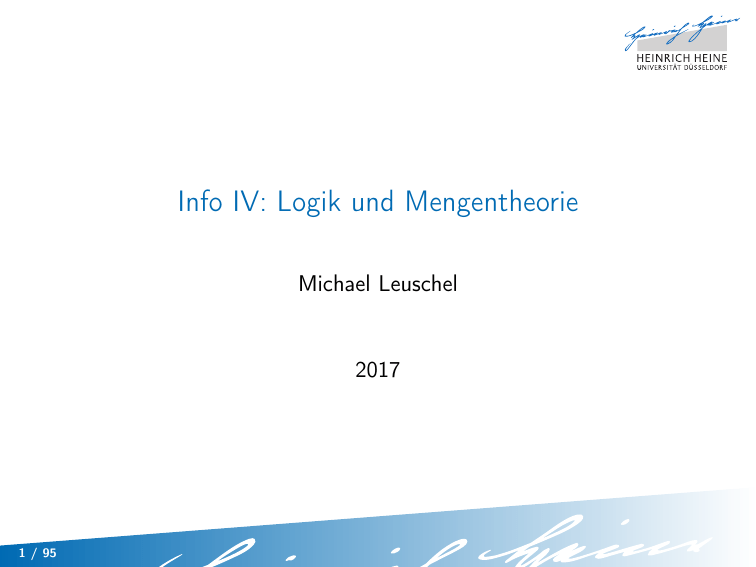
Info IV: Logik und Mengentheorie
Michael Leuschel
2017
1 / 95
Was ist Logik?
• Quelle:
http://www.3sat.de/page/?source=/philosophie/159958/index.html:
2 / 95
Was ist Logik?
• Quelle:
http://www.3sat.de/page/?source=/philosophie/159958/index.html:
• Was fällt ihnen zu Logik ein? “Mr. Spock”, Gehirnjogging,
Frauenlogik und Männerlogik...
• Wir sagen “klingt logisch.” Wenn etwas vernünftig klingt.
• Und “hä? Das ist doch total unlogisch!”, wenn wir etwas nicht
verstehen.
• Aber Logik ist mehr. Viel mehr.
2 / 95
Was ist Logik?
• Quelle https://de.wikipedia.org/wiki/Logik:
3 / 95
Was ist Logik?
• Quelle https://de.wikipedia.org/wiki/Logik:
• vernünftiges Schlussfolgern, Denklehre
• In der Logik wird die Struktur von Argumenten im Hinblick auf
ihre Gültigkeit untersucht, unabhängig vom Inhalt der
Aussagen
• Traditionell ist die Logik ein Teil der Philosophie.
• Seit dem 20. Jahrhundert versteht man unter Logik
überwiegend symbolische Logik, die auch als grundlegende
Strukturwissenschaft, z. B. innerhalb der Mathematik und der
theoretischen Informatik, behandelt wird.
3 / 95
Warum Logik studieren?
4 / 95
Warum Logik studieren?
• Hardware: logische Schaltkreise
• Wissensdarstellung und intelligentes Denken: künstliche
Intelligenz, deklarative Darstellung von Wissen, semantisches
Web, ...
• Überlegungen über Programme: Verifikation, statische
Programmanalyse, Programmoptimierung,...
• Universale Vorrichtung zur Berechnung: Datenbanken, logische
Programmierung, ...
4 / 95
Welche Logik studieren?
5 / 95
Welche Logik studieren?
• Aussagenlogik
• Prädikatenlogik der ersten Stufe (FOL)
• Logik höherer Stufe (HOL)
• eine temporale Logik
• eine mehrwertige Logik oder gar Fuzzy Logik
• Relevanzlogik, lineare Logik
• eine nichtmonotone Logik
Wir werden die klassische, zweiwertige, monotone Aussagenlogik
und Prädikatenlogik studieren (zusammen mit Mengentheorie).
5 / 95
Aussagenlogik
• eine Aussage identifizieren wir mit einem Bezeichner wie p
oder q
• eine Aussage ist entweder wahr (TRUE ) oder falsch (FALSE )
• die Logik interessiert sich weniger ob Aussagen wie p oder q
wahr oder falsch sind, sondern mehr um Zusammenhänge
zwischen möglichen Wahrheitswerten verschiedener Aussagen
und Formeln
6 / 95
Junktoren
• Aussagen können mit Junktoren zu Formeln verknüpft
werden:
• die Negation einer Aussage oder Formel p ist ¬p
• die Konjunktion von p und q ist p ∧ q
Intuitiv: sowohl p als auch q sind wahr
• die Disjunktion von p und q ist p ∨ q
Intuitiv: entweder p oder q (auch beide) sind wahr
• die Implikation von p nach q ist p ⇒ q
Intuitiv: wenn p wahr ist muss auch q wahr sein
• die Äquivalenz zwischen p und q ist p ⇔ q
Intuitiv: p und q haben den selben Wahrheitswert
7 / 95
Formale Definition einer Formel in Aussagenlogik
Sei gegeben eine Menge A an Aussagen. Die Menge FA der
Formeln in Aussagenlogik über A ist die kleinste Menge and
Formeln, so dass
• A ⊆ FA (jede Aussage ist auch eine Formel),
• wenn φ ∈ FA und ψ ∈ FA dann ist auch
• (¬φ) ∈ FA ,
• (φ ∧ ψ) ∈ FA ,
• (φ ∨ ψ) ∈ FA ,
• (φ ⇒ ψ) ∈ FA ,
• (φ ⇔ ψ) ∈ FA .
Anmerkung: wir werden später andere Arten der Definition von FA
sehen.
8 / 95
Prioritäten
Alle Formeln in FA sind komplett geklammert. Wir erlauben
alternative Schreibweisen, mit weniger oder mehr Klammern.
Ist je nach Buch, Vorlesung, Formalismus unterschiedlich. In der B
Sprache (mit der diese Folien erstellt wurden) haben wir:
• ¬ bindet am stärksten : ¬a ∧ b entspricht (¬a) ∧ b
• danach kommt ⇔ und ist links assoziativ:
a ⇔ b ⇔ c entspricht (a ⇔ b) ⇔ c
• ∧ and ∨ haben die gleiche Priorität und sind links assoziativ:
a ∧ b ∨ c entspricht (a ∧ b) ∨ c und
a ∨ b ∧ c entspricht (a ∨ b) ∧ c
• danach kommt ⇒ und ist links assoziativ:
a ⇒ b ⇒ c entspricht (a ⇒ b) ⇒ c
• im Zweifel lieber Klammern setzen !
Beispiel: d ⇔ a ∨ b ⇒ c ∧ d entspricht ((d ⇔ a) ∨ b) ⇒ (c ∧ d).
9 / 95
Beispiel: d ⇔ a ∨ b ⇒ c ∧ d entspricht ((d ⇔ a) ∨ b) ⇒ (c ∧ d).
=
true
d
<=>
false
d <=> a
=
false
a
or
true
d <=> a or b
=
true
b
&
true
c&d
=
true
c
=>
true
=
true
d
Im Zweifel lieber Klammern setzen !
10 / 95
Hardware Schaltung
• Aussage: Spannung an einem Punkt der Schaltung
• Welcher Formel in Aussagenlogik entspricht folgende
Schaltung?
11 / 95
Hardware Schaltung als Aussagenlogik Formel
• Formel für die Aussgabe e: (a ∨ b) ∧ c
• Formel für die gesamte Schaltung (mit Zwischenpunkten):
d ⇔ (a ∨ b) ∧ e ⇔ (c ∧ d )
• Frage: kann die Ausgabe e wahr werden? Wenn ja, für welche
Eingaben und Zwischenwerte? Wie kann einem die Logik dabei
helfen? d ⇔ (a ∨ b) ∧ e ⇔ (c ∧ d ) ∧ e
12 / 95
Interpretationen
• eine Interpretation i für eine Formel und eine Menge an
Aussagen A ist eine totale Funktion i ∈ A → {FALSE , TRUE }.
• Beispiel: eine mögliche Interpretation für p ∨ q ist
{p 7→ TRUE , q 7→ FALSE }.
• Insgesamt gibt es vier Interpretationen:
{p 7→ TRUE , q 7→ TRUE },{p 7→ TRUE , q 7→ FALSE },{p 7→
FALSE , q 7→ TRUE }, {p 7→ FALSE , q 7→ FALSE }.
13 / 95
Interpretation für Formeln
• gegeben eine Interpretation i ∈ A → {FALSE , TRUE }
• man kann damit den Wahrheitswert jeder Formel φ die
Aussagen in A benutzt berechnen:
• man berechnet den Wahrheitswert der Aussagen in φ mit i
• man berechnet den Wahrheitswert von immer grösseren
Unterformeln mit den Wahrheitstabellen der Junktoren
• Beispiel: gegeben i = {p 7→ TRUE , q 7→ FALSE } ist
i(p ∨ q) = TRUE , basierend auf der Tabelle für die
Disjunktion:
p
FALSE
FALSE
TRUE
TRUE
14 / 95
q
FALSE
TRUE
FALSE
TRUE
p∨q
FALSE
TRUE
TRUE
TRUE
Wahrheitstabellen
• Beispiel: gegeben i = {p 7→ TRUE , q 7→ FALSE } ist
i(p ⇔ (p ∨ q)) = TRUE , basierend auf:
p
FALSE
FALSE
TRUE
TRUE
15 / 95
q
FALSE
TRUE
FALSE
TRUE
¬p
TRUE
TRUE
FALSE
FALSE
p∧q
FALSE
FALSE
FALSE
TRUE
p∨q
FALSE
TRUE
TRUE
TRUE
p⇒q
TRUE
TRUE
FALSE
TRUE
p⇔q
TRUE
FALSE
FALSE
TRUE
Modelle
• eine Interpretation i so dass i(φ) = TRUE ist ein Modell für φ
• eine Formel φ die mindestens ein Modell hat heißt erfüllbar
• eine Formel φ wo alle Interpretationen auch Modelle sind wird
eine Tautologie genannt
• eine Formel ohne Modell heißt unerfüllbar oder ein
Widerspruch
p
FALSE
TRUE
16 / 95
¬p
TRUE
FALSE
p ∨ ¬p
TRUE
TRUE
p ∧ (¬p)
FALSE
FALSE
p ⇒ ¬p
TRUE
FALSE
Beispiel
φ = p ∨ (q ∧ r )
p
FALSE
FALSE
FALSE
FALSE
TRUE
TRUE
TRUE
TRUE
17 / 95
q
FALSE
FALSE
TRUE
TRUE
FALSE
FALSE
TRUE
TRUE
r
FALSE
TRUE
FALSE
TRUE
FALSE
TRUE
FALSE
TRUE
phi
FALSE
FALSE
FALSE
TRUE
TRUE
TRUE
TRUE
TRUE
Goldene Regel
Folgende Formel kommt aus dem Buch “A logical approach to
discrete math” von Gries und Schneider: φ =
(p ∧ q) ⇔ p ⇔ q ⇔ (p ∨ q).
Dies ist eine Tautologie:
p
FALSE
FALSE
TRUE
TRUE
18 / 95
q
FALSE
TRUE
FALSE
TRUE
p∧q
FALSE
FALSE
FALSE
TRUE
p∧q ⇔p
TRUE
TRUE
FALSE
TRUE
(p ∧ q ⇔ p) ⇔ q
FALSE
TRUE
TRUE
TRUE
φ
TRUE
TRUE
TRUE
TRUE
Modelle für Hardware Beispiel
• Frage: kann die Ausgabe e wahr werden?
• Entspricht der Frage: ist folgende Formel φ erfüllbar:
d ⇔ (a ∨ b) ∧ e ⇔ (c ∧ d ) ∧ e
Dies sind all Modelle von φ:
a
FALSE
TRUE
TRUE
19 / 95
b
TRUE
FALSE
TRUE
c
TRUE
TRUE
TRUE
d
TRUE
TRUE
TRUE
e
TRUE
TRUE
TRUE
Modell für Hardware Beispiel
Dies ist ein Modell von d ⇔ (a ∨ b) ∧ e ⇔ (c ∧ d ) ∧ e als
Formelbaum:
=
true
d
=
false
a
<=>
true
d <=> (a or b)
or
true
a or b
=
true
b
&
true
<=>
true
e <=> (c & d)
=
true
e
=
true
e
&
true
c&d
=
true
c
=
true
d
20 / 95
Äquivalenz von Formeln
Zwei Formeln sind äquivalent gdw sie die selben Modelle haben.
p
FALSE
FALSE
TRUE
TRUE
q
FALSE
TRUE
FALSE
TRUE
p⇒q
TRUE
TRUE
FALSE
TRUE
p ∨ (¬q)
TRUE
FALSE
TRUE
TRUE
(¬p) ∨ q
TRUE
TRUE
FALSE
TRUE
p ⇒ q und (¬p) ∨ q sind äquivalent. Wir schreiben dies auch als
p ⇒ q ≡ (¬p) ∨ q.
Anmerkung (p ⇒ q) ⇔ ((¬p) ∨ q) ist eine Tautologie.
21 / 95
Wichtige Äquivalenzen
Für alle Formeln φ, ψ gilt:
• φ ⇒ ψ ≡ (¬φ) ∨ ψ
• φ ⇔ ψ ≡ (φ ⇒ ψ) ∧ (ψ ⇒ φ)
• ¬¬φ ≡ φ
• ¬(φ ∧ ψ) ≡ (¬φ) ∨ (¬ψ)
• ¬(φ ∨ ψ) ≡ (¬φ) ∧ (¬ψ)
• φ∧ψ ≡ψ∧φ
• φ∨ψ ≡ψ∨φ
22 / 95
Kontraposition
¬ψ ⇒ ¬φ ist die Kontraposition von φ ⇒ ψ. Ist diese Form
äquivalent? Zur Prüfung kann man die komplette Wahrheitstabelle
aufbauen, mit allen möglichen Werten für die offenen Formeln φ, ψ:
p
FALSE
FALSE
TRUE
TRUE
23 / 95
q
FALSE
TRUE
FALSE
TRUE
p⇒q
TRUE
TRUE
FALSE
TRUE
¬q ⇒ ¬p
TRUE
TRUE
FALSE
TRUE
Logisches Schließen von Formeln
• Wenn p ∧ q gilt, dann ist p eine logische Konsequenz
(Schlussfolgerung) von p ∧ q.
• Wir schreiben dies als p ∧ q |= p
• Formal bedeutet dies, dass alle Modelle von q ∧ p auch
Modelle von p sind.
• Die Tabelle zeigt, dass p ⇔ q |= p ⇒ q. Die Formeln sind
nicht äquivalent.
p
FALSE
FALSE
TRUE
TRUE
24 / 95
q
FALSE
TRUE
FALSE
TRUE
p⇔q
TRUE
FALSE
FALSE
TRUE
p⇒q
TRUE
TRUE
FALSE
TRUE
Wichtige logische Schlussfolgerungen
Für alle Formeln φ, ψ gilt:
• φ ∧ ψ |= φ
• (φ ⇒ ψ) ∧ φ |= ψ (Modus Ponens)
• (φ ⇒ ψ) ∧ ¬ψ |= ¬φ (Modus Tollens)
• (φ ⇔ ψ) ∧ ψ |= φ
• (φ ⇔ ψ) ∧ ¬ψ |= ¬φ
• Achtung φ ∧ ¬φ |= ψ für beliebiges ψ !
25 / 95
Smullyan - Einfaches Puzzle
Raymond Smullyan beschreibt in seinen Büchern eine Insel auf der
es zwei Arten von Personen gibt:
• Ritter die immer die Wahrheit sagen, und
• Schurken die immer lügen.
26 / 95
1
X sagt: “Y ist ein Ritter”
2
Y sagt: “X und ich sind von einem unterschiedlichen Typ.”
Smullyan - Einfaches Puzzle
1
X sagt: “Y ist ein Ritter”
X ⇔Y
2
Y sagt: “X und ich sind von einem unterschiedlichen Typ.”
Y ⇔ (X ⇔ ¬(Y ))
X
FALSE
FALSE
TRUE
TRUE
27 / 95
Y
FALSE
TRUE
FALSE
TRUE
Satz1
TRUE
FALSE
FALSE
TRUE
Satz2
TRUE
TRUE
FALSE
FALSE
Puzzle
TRUE
FALSE
FALSE
FALSE
Smullyan - Tiger und Prinzessin Puzzle (3)
Puzzle aus “The Lady or the Tiger” von Raymond Smullyan.
• Hinter jeder Kerkertür gibt es entweder ein Tiger (der einen
sofort auffrisst) oder eine Prinzessin (und man ist frei)
• In diesem Puzzle gibt es zwei Türen mit jeweils einem Zettel
• Entweder sagen beide Zettel die Wahrheit oder beide sind
falsch
• Zettel auf Tür 1: Es ist ein Tiger hinter dieser Tür oder eine
Prinzessin hinter der anderen Tür
• Zettel auf Tür 2: Hinter der anderen Tür befindet sich eine
Prinzessin
Soll der Gefangene eine Tür aufmachen? Wenn ja, welche?
28 / 95
Smullyan - Tiger und Prinzessin Puzzle (3) - Lösung
• Entweder sagen beide Zettel die Wahrheit oder beide sind
falsch
φ = Z1 ⇔ Z2
• Tür 1: Es ist ein Tiger hinter dieser Tür oder eine Prinzessin
hinter der anderen Tür
Z 1 = T1 ∨ ¬(T2 )
• Tür 2: Hinter der anderen Tür befindet sich eine Prinzessin
Z 2 = ¬(T1 )
• φ |= ¬T 1 ∧ ¬T 2 (man kann beide Türen aufmachen)
T1
FALSE
FALSE
TRUE
TRUE
29 / 95
T2
FALSE
TRUE
FALSE
TRUE
Z1
TRUE
FALSE
TRUE
TRUE
Z2
TRUE
TRUE
FALSE
FALSE
Phi
TRUE
FALSE
FALSE
FALSE
Smullyan - Tiger und Prinzessin Puzzle (6)
• Hinter jeder Kerkertür gibt es entweder ein Tiger (der einen
sofort auffrisst) oder eine Prinzessin (und man ist frei)
• In diesem Puzzle gibt es zwei Türen mit jeweils einem Zettel
• Zettel 1 sagt die Wahrheit gdw eine Prinzessin hinter der Tür
ist
• Zettel 2 sagt die Wahrheit gdw ein Tiger hinter der Tür ist
• Zettel auf Tür 1: Wähle eine der beiden Türen; es macht
keinen Unterschied.
• Zettel auf Tür 2: Hinter der anderen Tür befindet sich eine
Prinzessin
Soll der Gefangene eine Tür aufmachen? Wenn ja, welche?
30 / 95
Smullyan - Tiger und Prinzessin Puzzle (6) - Lösung
• Zettel 1 (2) sagt die Wahrheit gdw eine Prinzessin (Tiger)
hinter der Tür ist
φ = Z1 ⇔ ¬(T1 ) ∧ Z2 ⇔ T2
• Tür 1: Wähle eine der beiden Türen; es macht keinen
Unterschied
Z 1 = T1 ⇔ T2
• Tür 2: Hinter der anderen Tür befindet sich eine Prinzessin
Z 2 = ¬(T1 )
• φ |= T 1 ∧ ¬T 2 (Tür 2 aufmachen)
T1
FALSE
FALSE
TRUE
TRUE
31 / 95
T2
FALSE
TRUE
FALSE
TRUE
Z1
TRUE
FALSE
FALSE
TRUE
Z2
TRUE
TRUE
FALSE
FALSE
Phi
FALSE
FALSE
TRUE
FALSE
Deduktiver Beweis
1
φ1
2
φ2
3
...
4
φk
wo immer gilt φ1 ∧ ...φi |= φi+1 .
Wir haben per Transitivität von |=, dass φ1 |= φk .
32 / 95
Deduktiver Beweis (Beispiel)
Kleines anderes Insel-Puzzle:
1
φ1 =
A ⇔ B ∧ (A sagt: “B ist ein Ritter”)
B ⇔ ⊥ (B sagt: “1+1=3”)
2
¬B (nach der zweiten Aussage muss B ein Schurke sein)
3
¬A (nach der ersten Aussage muss A demnach auch ein Schurke sein)
Wir haben per Transitivität von |=, dass φ1 |= ¬A.
(φ1 |= φ1 ∧ ¬B |= ¬A)
33 / 95
Äquivalenzbeweis
Hier schreiben wir in der Regeln in folgender Form:
1
φ1
2
⇐⇒ φ2
3
...
4
⇐⇒ φk
wo immer gilt φi ≡ φi+1 .
Wir haben per Transitivität von ≡, dass φ1 ≡ φk .
Kleines Beispiel, beweise, dass ¬b ⇒ a ≡ a ∨ b:
34 / 95
1
¬b ⇒ a
2
⇐⇒ ¬¬b ∨ a (Regel: φ ⇒ ψ ≡ ¬φ ∨ ψ)
3
⇐⇒ b ∨ a (Regel: ¬¬φ ≡ φ))
4
⇐⇒ a ∨ b (Kommutativität von ∨)
Beweis durch Widerspruch
• Theorem: φ |= ψ genau dann wenn φ ∧ ¬ψ kein Modell hat
Beweis (ist ein Äquivalenzbeweis auf Metaebene):
• φ |= ψ
• ⇐⇒ alle Modelle von φ sind auch Modelle von ψ (per
Definition von |=)
• ⇐⇒ in allen Modellen von φ hat ¬ψ den Wahrheitswert falsch
(per Definition von ¬)
• ⇐⇒ alle Modelle von φ sind kein Modell von φ ∧ ¬ψ (per
Definition von ∧)
• ⇐⇒ φ ∧ ¬ψ hat kein Modell (da auch kein Modell von ¬φ ein
Modell von φ ∧ ¬ψ sein kann)
35 / 95
Smullyan Arthur York - Inspektor Craig Puzzle
• Knights (Ritter): sagen immer die Wahrheit, Knaves
(Schurken): lügen immer
• Arthur York wird von Inspektor Craig gesucht und ist ein Ritter
oder Schurke, der Angeklagte ist auch ein Ritter oder Schurke.
• Auszug aus "To Mock a Mockingbird, Raymond
Smullyan"(Seite 41, The First Trial).
•
•
•
•
Craig: What do you know about Arthur York
Angeklagter: Arthur York once claimed that I was a knave.
Craig: Are you by any chance Arthur York?
Angeklagter: Yes
Folgt aus dieser logischen Theorie, dass der Angeklagte Arthur York
ist?
36 / 95
Smullyan Puzzle: Lösung
• Aussage YR ist wahr wenn Arthur York ein Ritter ist,
• Aussage Schuldig ist wahr wenn der Angeklagte Arthur York
ist,
• Aussage AR ist wahr wenn der Angeklagte ein Ritter ist.
• Wir wissen auch (φ1 ) Schuldig ⇒ YR ⇔ AR
• Angeklagter: Arthur York once claimed that I was a knave
(φ2 ): AR ⇒ YR ⇔ ¬(AR)
• Craig: Are you by any chance Arthur York? Angeklagter: Yes
(φ3 ): AR ⇔ Schuldig
Die Konjunktion φ = φ1 ∧ φ2 ∧ φ3 dieser Formeln hat nur zwei
Modelle, wir haben φ |= ¬Schuldig :
YR
FALSE
TRUE
37 / 95
Schuldig
FALSE
FALSE
AR
FALSE
FALSE
Smullyan Puzzle: Lösung
• (φ1 ) Schuldig ⇒ YR ⇔ AR
• (φ2 ): AR ⇒ YR ⇔ ¬(AR)
• (φ3 ): AR ⇔ Schuldig
Die Konjunktion φ hat nur zwei Modelle, wir haben φ |= ¬Schuldig :
YR
FALSE
FALSE
FALSE
FALSE
TRUE
TRUE
TRUE
TRUE
38 / 95
Schuldig
FALSE
FALSE
TRUE
TRUE
FALSE
FALSE
TRUE
TRUE
AR
FALSE
TRUE
FALSE
TRUE
FALSE
TRUE
FALSE
TRUE
Phi1
TRUE
TRUE
TRUE
FALSE
TRUE
TRUE
FALSE
TRUE
Phi2
TRUE
TRUE
TRUE
TRUE
TRUE
FALSE
TRUE
FALSE
Phi3
TRUE
FALSE
FALSE
TRUE
TRUE
FALSE
FALSE
TRUE
Phi
TRUE
FALSE
FALSE
FALSE
TRUE
FALSE
FALSE
FALSE
Smullyan Puzzle: Beweis durch Widerspruch
• unsere Theorie: φ = Schuldig ⇒ YR ⇔ AR ∧
AR ⇒ YR ⇔ ¬(AR) ∧ AR ⇔ Schuldig
• um zu Beweisen dass φ |= ¬Schuldig gilt
• negieren wir was wir beweisen wollen: ¬¬Schuldig = Schuldig
•
•
•
•
•
(auf Deutsch: nehmen wir an der Angeklagte ist Arthur York)
fügen dies zur Theorie hinzu: φ ∧ Schuldig
und zeigen, dass dies ein Widerspruch ist (kein Modell hat)
d.h., in allen Modellen von φ ist Schuldig falsch
d.h., in allen Modellen von φ ist ¬Schuldig wahr
d.h., wir haben bewiesen, dass φ |= ¬Schuldig
• (siehe unser Theorem: φ |= ψ genau dann wenn φ ∧ ¬ψ kein
Modell hat)
39 / 95
Smullyan Puzzle: Beweis durch Widerspruch im Detail
40 / 95
1
(φ ⇔ ψ) ∧ ψ |= φ
2
Schuldig ⇒ YR ⇔ AR
3
AR ⇒ YR ⇔ ¬(AR)
4
AR ⇔ Schuldig
5
Schuldig (Nehmen wir an der Angeklagte ist Arthur York)
6
Aus 4 und 5 (und Regel 1) folgt: AR (der Angeklagte ist ein Ritter)
7
Aus 6 und 3, folgt durch die Modus Ponens Regel dass:
(YR ⇔ ¬AR) (Arthur York once claimed that I was a knave)
8
Aus 7 und 6 folgt: ¬YR (Arthur York ist ein Schurke)
9
Aus 2 und 5 folgt: YR ⇔ AR,
10
Aus 9 und 8 folgt: ¬AR (der Angeklagte ist ein Schurke)
11
Die Aussagen 6 und 10 sind im Widerspruch, der Angeklagte
ist nicht schuldig.
Modell in der formalen Sprache Event-B
Anmerkung: in B/Event-B müssen Aussagen wie AR durch eine Bool’sche
Variable modelliert werden. Die Aussage AR entspricht AR = TRUE in B,
¬AR entspricht entweder AR = FALSE , AR 6= TRUE oder ¬(AR = TRUE ).
Die Symbole = und 6= stehen hier für Prädikate (sehen wir später).
41 / 95
Beweisobligation (Proof Obligation auf Englisch)
Dies ist die aus dem Modell generierte Beweisobligation:
φ1 ∧ φ2 ∧ φ3 |= ¬Schuldig :
Der Beweis auf der nächste Folie ist sehr ähnlich zu unserem
Beweis, man sieht, dass AR und ¬AR abgeleitet wurden.
42 / 95
Beweis in der formalen Sprache Event-B
43 / 95
Graph-Färbung
Gegeben zwei Farben (Rot und Grün) sollen die Knoten in
folgendem Graphen g so eingefärbt werden, dass Nachbarn
unterschiedliche Farben haben:
"c"
gg
"b"
gg
"a"
Wie kann man dies Problem in Aussagenlogik lösen?
44 / 95
Modelle für Graph-Färbung
• Aussage ar : Knoten a ist rot gefärbt, Aussage ag : Knoten a ist
grün gefärbt, Aussage br : Knoten b ist rot gefärbt, ...
• ar ⇔ ¬(ag ) sagt aus, dass wir für a entweder rot oder grün
wählen müssen
• ar ⇒ ¬(br ) sagt aus, dass a und b nicht gleichzeitig rot sein
dürfen
• Dies sind alle Modelle von
(ar ⇒ ¬(br )) ∧ (ag ⇒ ¬(bg )) ∧ (br ⇒ ¬(cr )) ∧ (bg ⇒
¬(cg )) ∧ ar ⇔ ¬(ag ) ∧ br ⇔ ¬(bg ) ∧ cr ⇔ ¬(cg ):
ar
FALSE
TRUE
45 / 95
br
TRUE
FALSE
cr
FALSE
TRUE
ag
TRUE
FALSE
bg
FALSE
TRUE
cg
TRUE
FALSE
Modell für Graph-Färbung
Dies ist ein Modell von (ar ⇒ ¬(br )) ∧ (ag ⇒ ¬(bg )) ∧ (br ⇒
¬(cr )) ∧ (bg ⇒ ¬(cg )) ∧ ar ⇔ ¬(ag ) ∧ br ⇔ ¬(bg ) ∧ cr ⇔ ¬(cg )
als Formelbaum:
=
false
br
=
true
cr
not
false
not(cr)
not
true
not(br)
=
false
br
=
true
ar
=>
true
br => not(cr)
=>
true
ar => not(br)
=
true
bg
=
false
cg
not
true
not(cg)
not
false
not(bg)
=>
true
bg => not(cg)
&
true
<=>
true
ar <=> not(ag)
not
true
not(ag)
=
true
cr
<=>
true
cr <=> not(cg)
=>
true
ag => not(bg)
=
false
ag
<=>
true
br <=> not(bg)
=
false
br
=
true
ar
=
false
ag
not
true
not(cg)
not
false
not(bg)
=
true
bg
=
false
cg
46 / 95
=
true
bg
Auf zur Prädikatenlogik und Mengentheorie
• man kann mit Aussagenlogik viel tun
• SAT-Solver skalieren erstaunlich gut
• Kodierung grösserer Probleme ist für den Menschen nicht mehr
lesbar: (ar ⇒ ¬(br )) ∧ (ag ⇒ ¬(bg )) ∧ (br ⇒ ¬(cr )) ∧ (bg ⇒
¬(cg )) ∧ ar ⇔ ¬(ag ) ∧ br ⇔ ¬(bg ) ∧ cr ⇔ ¬(cg )
• in Prädikatenlogik und Mengentheorie kann man das
Graphfärbungsproblem für einen beliebigen Graphen gr und
zwei Farben so ausdrücken:
col ∈ V → {red , green}
∀(x, y ).(x 7→ y ∈ gr ⇒ col (x) 6= col (y ))
47 / 95
Färbung mit Prädikatenlogik - 60 Knoten, 400 Kanten
Man kann auch versuchen die minimale Anzahl an Farben zu finden:
34
custom
12
custom
52
custom
custom
custom
custom
22
custom
custom
custom
custom
57
20
custom
custom
custom
8
custom
custom
6
custom
27
custom
custom
custom
custom
custom
custom
custom
custom
custom custom
custom
21
custom
custom
custom
custom
custom
31
custom
custom
custom
custom
custom
custom
custom
custom
30custom
custom
custom
custom40 custom
custom
custom
custom
custom custom
custom
25
custom
custom
custom
custom
custom
custom
custom
custom
custom
custom
32
custom
13
custom
14
custom
54
custom
custom
custom
custom
custom
custom
custom
9
custom
5
48 / 95
custom
custom
custom
custom
custom
custom
56
custom
custom
custom custom
18
custom
custom
custom
custom
custom
custom
custom
custom
custom
custom
58
custom
custom
custom
custom
custom
26
custom custom
custom
custom
custom
custom
custom
custom
custom
custom
custom
custom
custom
custom
custom
custom
custom
custom
custom
custom
custom custom
custom
custom custom
custom
custom
custom
custom
customcustom
custom custom
customcustom
custom
custom custom
custom
custom
38
custom
50
custom
custom custom
custom custom
custom
1
custom
custom
43
3
custom custom 44
custom
custom
custom
custom
customcustom
custom
custom
custom
custom
custom
custom
custom
custom
custom
custom
custom
custom
custom
custom
custom
custom custom
custom
custom custom custom
custom
custom
customcustom
custom
custom
custom custom
17
custom
custom
custom
51
custom
custom
custom
custom
custom
custom
custom custom
custom
custom
42
custom
custom
custom
custom
custom
custom custom
custom custom
11
custom
custom
custom
36
custom custom
custom custom
custom custom
custom
custom
custom
custom
custom
custom
custom
custom
custom
custom
custom
custom
custom
custom
custom custom custom
custom
custom custom
custom16
custom custom
4
28
custom
custom
custom
custom
custom
customcustom custom
custom
48
custom
custom
custom
custom
custom
custom
custom
custom
custom
custom
custom
19
custom
custom
custom
customcustomcustom
custom
custom custom custom
custom
custom
custom
custom
custom
custom
custom
custom
custom
custom
custom custom custom
24
37
custom custom
custom
custom custom
custom
custom
custom
custom
custom
custom
custom
custom
custom
custom
custom
53
custom 2
custom
custom
custom
custom
custom customcustom
custom
custom
custom 49
custom
custom
60
41
custom
custom
custom
custom
custom
custom
custom
custom
custom
custom
customcustom
35
custom
custom
custom
custom
custom custom
custom
custom
custom
custom
custom
custom
47
custom
customcustom
custom
custom
custom
custom
custom
23
custom
customcustom
custom
custom
custom
custom
custom
custom custom
custom
custom
15
custom
10
33
custom
custom
customcustomcustom
custom
custom
custom
custom custom
custom
custom custom
custom
59
custom
custom
custom
custom
custom
custom
custom
custom
46
custom
45
custom
custom custom
29
7
39
custom
custom custom
custom
custom
customcustom custom
custom
custom
custom
custom
custom
custom
custom custom
custom
55
Färbung mit Prädikatenlogik - Lösung mit ProB
Man kann auch versuchen die minimale Anzahl an Farben zu finden:
34
custom
12
custom
52
custom
custom
custom
custom
22
custom
custom
custom
custom
57
20
custom
custom
custom
8
custom
custom
6
custom
27
custom
custom
custom
custom
custom
custom
custom
custom
custom custom
custom
21
custom
custom
custom
custom
custom
31
custom
custom
custom
custom
custom
custom
custom
custom
30custom
custom
custom
custom40 custom
custom
custom
custom
custom custom
custom
25
custom
custom
custom
custom
custom
custom
custom
custom
custom
custom
32
custom
13
custom
14
custom
54
custom
custom
custom
custom
custom
custom
custom
9
custom
5
49 / 95
custom
custom
custom
custom
custom
custom
56
custom
custom
custom custom
18
custom
custom
custom
custom
custom
custom
custom
custom
custom
custom
58
custom
custom
custom
custom
custom
26
custom custom
custom
custom
custom
custom
custom
custom
custom
custom
custom
custom
custom
custom
custom
custom
custom
custom
custom
custom
custom custom
custom
custom custom
custom
custom
custom
custom
customcustom
custom custom
customcustom
custom
custom custom
custom
custom
38
custom
50
custom
custom custom
custom custom
custom
1
custom
custom
43
3
custom custom 44
custom
custom
custom
custom
customcustom
custom
custom
custom
custom
custom
custom
custom
custom
custom
custom
custom
custom
custom
custom
custom
custom custom
custom
custom custom custom
custom
custom
customcustom
custom
custom
custom custom
17
custom
custom
custom
51
custom
custom
custom
custom
custom
custom
custom custom
custom
custom
42
custom
custom
custom
custom
custom
custom custom
custom custom
11
custom
custom
custom
36
custom custom
custom custom
custom custom
custom
custom
custom
custom
custom
custom
custom
custom
custom
custom
custom
custom
custom
custom
custom custom custom
custom
custom custom
custom16
custom custom
4
28
custom
custom
custom
custom
custom
customcustom custom
custom
48
custom
custom
custom
custom
custom
custom
custom
custom
custom
custom
custom
19
custom
custom
custom
customcustomcustom
custom
custom custom custom
custom
custom
custom
custom
custom
custom
custom
custom
custom
custom
custom custom custom
24
37
custom custom
custom
custom custom
custom
custom
custom
custom
custom
custom
custom
custom
custom
custom
custom
53
custom 2
custom
custom
custom
custom
custom customcustom
custom
custom
custom 49
custom
custom
60
41
custom
custom
custom
custom
custom
custom
custom
custom
custom
custom
customcustom
35
custom
custom
custom
custom
custom custom
custom
custom
custom
custom
custom
custom
47
custom
customcustom
custom
custom
custom
custom
custom
23
custom
customcustom
custom
custom
custom
custom
custom
custom custom
custom
custom
15
custom
10
33
custom
custom
customcustomcustom
custom
custom
custom
custom custom
custom
custom custom
custom
59
custom
custom
custom
custom
custom
custom
custom
custom
46
custom
45
custom
custom custom
29
7
39
custom
custom custom
custom
custom
customcustom custom
custom
custom
custom
custom
custom
custom
custom custom
custom
55
Aristoteles: Anfänge der Logik
Syllogistik, einer Vorform der Prädikatenlogik
1
Alle Menschen sind sterblich.
2
Einige Menschen sind sterblich.
3
Alle Menschen sind unsterblich.
4
Einige Menschen sind unsterblich.
Zusammenhang unter der Annahme, daß es mindestens einen
Mensch gibt. (In die Aussagenlogik sind alle vier Aussagen
unabhängig.)
50 / 95
Aristoteles: Anfänge der Logik
Syllogistik, einer Vorform der Prädikatenlogik
1
Alle Menschen sind sterblich.
2
Einige Menschen sind sterblich.
3
Alle Menschen sind unsterblich.
4
Einige Menschen sind unsterblich.
Zusammenhang unter der Annahme, daß es mindestens einen
Mensch gibt. (In die Aussagenlogik sind alle vier Aussagen
unabhängig.)
• (1) |= (2), (3) |= (4)
• (1) ≡ ¬(4), (3) ≡ ¬(2)
• |= ¬((1) ∧ (3))
50 / 95
Prädikatenlogik
Im Vergleich zur Aussagenlogik mit den Wahrheitswerten
(TRUE ,FALSE ) und Aussagen, gibt es in der Prädikatenlogik:
• Objekte
• Konstanten und Variablen die Objekte darstellen,
• Funktionen die Objekte auf Objekte abbilden,
• Prädikate die Objekte oder Objekt-kombinationen auf einen
Wahrheitswert abbilden,
• Quantoren mit denen man Variablen einführt und Aussagen
über alle Objekte machen kann, oder die Existenz eines
Objekts zusichert
51 / 95
Prädikate
• “der Knoten a ist rot gefärbt” ist für ein bekanntes a eine
Aussage: sie ist entweder wahr oder falsch
• “die Farbe des Knotens a” ist keine Aussage: der Satz ist nicht
wahr oder falsch, sondern stellt ein Objekt dar
• “2+2 < 5” ist eine Aussage
• “x < 5” falls der Wert von x nicht bestimmt ist, ist dies keine
Aussage, der Wahrheitswert hängt von dem Wert der Variable
x ab
• “x < 5” ist ein Prädikat, für jeden möglichen Wert von x
können wir bestimmen ob das Prädikat wahr oder falsch ist
• Prädikate sind parametrisierte Aussagen
52 / 95
Prädikate
• LT 5(x) ≡ x < 5 ist ein unäres Prädikat, für jeden möglichen
Wert von x können wir bestimmen ob das Prädikat wahr oder
falsch ist, grafisch :
7
6
LT5 LT5
5
4
LT5
3
2
LT5 LT5 LT5
FALSE
1
LT5
TRUE
• < ist ein binäres Prädikat, für jede Kombination an Werten
können wir bestimmen ob das Prädikat wahr oder falsch ist:
x
1
1
2
2
53 / 95
y
1
2
1
2
x <y
FALSE
TRUE
FALSE
FALSE
freie Variablen
Die Formel x < 5 besteht formal gesehen aus:
• einer logischen Variable x,
• der Konstante 5 die für die Zahl 5 steht,
• dem binären Prädikatensymbol <, hier in Infix-Notation, mit
zwei Argumenten: x und 5.
• (In Präfix-Notation würde man < (x, 5) schreiben.)
Innerhalb von x < 5 ist x eine freie Variable.
In einer geschlossenen Formel der Prädikatenlogik müssen alle
Variablen durch Quantoren gebunden werden.
54 / 95
Quantoren
Es gibt zwei Quantoren:
• den Existenzquantor ∃
∃x.P, bedeutet, dass es ein Objekt o gibt, so dass wenn man x
durch o in P ersetzt die Formel wahr ist
• den Allquantor ∀
∀x.P bedeutet dass die Formel P für alle möglichen
Ersetzungen von x durch ein Objekt o wahr ist
• ∃x.x < 5 ist eine geschlossene Formel (aka eine Aussage). Mit
der Standardinterpretation von < und 5 ist diese Formel wahr;
eine Lösung ist x = 4.
• ∀x.x < 5 ist auch eine geschlossene Formel. Mit der
Standardinterpretation von < und 5 ist diese Formel falsch.
Ein Gegenbeispiel ist x = 5.
55 / 95
Logische Äquivalenz, Schlussfolgerung
Zwei Formeln φ und ψ sind äquivalent gdw sie die selben Modelle
haben. Wir schreiben dies als φ ≡ ψ.
Eine Formel ψ ist eine logische Schlussfolgerung von φ, wenn alle
Modelle von φ auch Modelle von ψ sind. Wir schreiben dies als
φ |= ψ.
Dies ist die gleiche Definition wie bei Aussagenlogik, nur das
Konzept der Modelle ist komplizierter:
• eine Menge an Objekten muss ausgewählt werden
• die Konstanten und Funktionen müssen den Objekten
zugeordnet werden
• die Prädikate müssen Objekte auf Wahrheitswerte abbilden;
Aussagen sind ein Spezialfall von Prädikaten.
• (manchmal sind bestimmte Symbole vordefiniert, wie <, +
oder 5)
56 / 95
Quantoren: Gesetze
Welche dieser Gesetze sind richtig? Beispiele?
57 / 95
1
¬∃x.P ≡ ∀x.¬P ?
2
¬∀x.P ≡ ∃x.¬P ?
3
∀x.(∀y .P) ≡ ∀y .(∀x.P) ?
4
∀x.(∃y .P) ≡ ∃y .(∀x.P) ?
5
∃x.(∃y .P) ≡ ∃y .(∃x.P) ?
Quantoren: Gesetze
58 / 95
1
¬∃x.P ≡ ∀x.¬P
¬∃x.(x > 0 ∧ x < 0) ≡ ∀x.¬(x > 0 ∧ x < 0) ≡
∀x.(x ≤ 0 ∨ x ≥ 0)
2
¬∀x.P ≡ ∃x.¬P
3
∀x.(∀y .P) ≡ ∀y .(∀x.P)
∀x.(∀y .(x ≤ y ∨ x > y )) ≡ ∀y .(∀x.(x ≤ y ∨ x > y ))
4
∀x.(∃y .P) 6≡ ∃y .(∀x.P)
∀x.(∃y .(y > x)) 6≡ ∃y .(∀x.(y > x)
5
∃x.(∃y .P) ≡ ∃y .(∃x.P)
Funktionen, Terme und Formeln
In der Formel x + 1 > 5 steht + für eine Funktion die Objekte auf
Objekte abbildet.
• Terme stehen für Objekte und sind Konstanten, Variablen
oder Funktionssymbole angewandt auf Terme.
• Formeln sind Aussagen, Prädikate angewandt auf Terme,
Formeln verknüpft mit Junktoren (∧, ∨, ...) oder Quantoren.
• x + 1 ist ein Term
• x + 1 > 5 ist eine Formel mit freien Variablen
• ∃x.x + 1 > 5 ist eine wohl-geformte Formel (ohne freie
Variablen)
59 / 95
Werkzeuge für Logik
• SAT Solver: Erfüllbarkeit von Aussagenlogik prüfen (miniSAT,
glucose, lingeling, Sat4j,...)
• SMT Solver: Erfüllbarkeit von Prädikatenlogik mit Theorien
(Bit-Vektoren,...): Z3 von Microsoft
• Beweiser: Atelier-B, Rodin, Isabelle, Coq, Vampire,...
• Model-Finder, Constraint Solver: ProB, Alloy, IDP, ...
• Programmiersprache: Prolog
• Hardware Verifikation
• schwere Probleme lösen (Eclipse/Linux Abhängigkeiten,...)
• Software Verifikation, Fehler finden (NullPointer Exception,
Overflows), Windows Driver Verification (SLAM2,...)
• Stellwerkprüfung (Prover Technologies, ...)
• Datenvalidierung (ProB bei Siemens, Alstom, Thales; Paris L1)
• Software Entwicklung (AtelierB, Paris L14, L1, ....: seit 1999
kein einziger Bug !)
60 / 95
Andere Logiken
• Aussagenlogik und Prädikatenlogik sind klassische zweiwertige
Logiken
• sie sind monoton wenn φ |= ψ dann gilt für alle ρ: φ ∧ ρ |= ψ
• Aussagenlogik ist entscheidbar
• Prädikatenlogik ist semi-entscheidbar: wenn φ |= ψ kann man
einen Beweis finden (Gödelscher Vollständigkeitssatz)
• reine Prädikatenlogik ist nicht ausreichend um Arithmetik zu
axiomatisieren (Gödelscher Unvollständigkeitssatz)
• es gibt Intuitionistische Logik: Beweis durch Widerspruch dort
nicht erlaubt
• es gibt dreiwertige Logiken ( 2/0 = 1 ∧ 1 = 2 )
• es gibt die Fuzzy Logik, modale Logiken, temporale Logiken,...
• nicht-monotone Logiken
61 / 95
Zusammenfassung Logik
• Aussagenlogik und Prädikatenlogik
• Interpretation, Modell, Äquivalenz (≡), logisches Schließen
(|=)
• Deduktiver Beweis, Äquivalenzbeweis
• Beweis durch Widerspruch
• Äquivalenzen (Kommutativität, de Morgan, ...)
• logische Formeln verstehen und erstellen können
62 / 95
Mengen
• Fundamentale Idee der Mengentheorie: "The ability to regard
any collection of objects as a single entity (i.e., as a
set)."(Keith Devlin. Joy of Sets.)
• wenn a ein Objekt ist und x eine Menge, dann
• ist a ∈ x wahr, wenn a ein Element von x ist
• ist a 6∈ x wahr, wenn a kein Element von x ist.
• ∈ und 6∈ sind Prädikate, mit der Eigenschaft:
∀(a, x).(a 6∈ x ⇔ ¬(a ∈ x))
• die leere Menge ∅ hat keine Elemente:
z = ∅ ⇔ ∀(a).(a 6∈ z)
63 / 95
Vereinigung, Schnitt, Differenz
• Vereinigung von Mengen ∪ :
z = x ∪ y ⇔ ∀(a).(a ∈ z ⇔ (a ∈ x ∨ a ∈ y ))
• {2, 3, 5} ∪ {5, 7} = {2, 3, 5, 7}
• Schnitt von Mengen ∩:
z = x ∩ y ⇔ ∀(a).(a ∈ z ⇔ (a ∈ x ∧ a ∈ y ))
• {2, 3, 5} ∩ {5, 7} = {5}
• Differenz von Mengen \:
z = x \ y ⇔ ∀(a).(a ∈ z ⇔ (a ∈ x ∧ a 6∈ y ))
• {2, 3, 5} − {5, 7} = {2, 3}
64 / 95
Notationen für Mengen: endliche Enumeration
• explizite Auflistung aller Elemente {a1 , . . . , an }
• die Reihenfolge spielt keine Rolle
• {2, 5, 3} = {2, 3, 5}
• Elemente können mehrfach auftauchen
• {2, 5, 3, 2, 5} = {2, 3, 5}
65 / 95
Notationen für Mengen: per Prädikat
• Definition der Elemente durch ein Prädikat {a | P(a)}
z = {a | P(a)} ⇔ ∀(a).(a ∈ z ≡ P(a))
• {a|a > 1 ∧ a < 6 ∧ a 6= 4} = {2, 3, 5}
• Man kann unendliche Mengen ausdrücken:
{a|a > 10}
• Andere Beispiele:
x ∪ y = {a | a ∈ x ∨ a ∈ y }
x ∩ y = {a | a ∈ x ∧ a ∈ y }
x \ y = {a | a ∈ x ∧ a 6∈ y }
Als Kürzel führen wir auch die Notation a..b für
{x | x ≥ a ∧ x ≤ b} ein.
66 / 95
Ein Theorem
Für alle Mengen x, y , z gilt:
• x ∪ (y ∩ z) = (x ∪ y ) ∩ (x ∪ z)
Beispiel:
• {2, 3, 5} ∪ ({2, 4, 7} ∩ {2, 4, 6}) = {2, 3, 4, 5}
• ({2, 3, 5} ∪ {2, 4, 7}) ∩ ({2, 3, 5} ∪ {2, 4, 6}) = {2, 3, 4, 5}
x
y
67 / 95
z
Beweis von x ∪ (y ∩ z) = (x ∪ y ) ∩ (x ∪ z)
Lemmata:
1 x ∪ y = {a | a ∈ x ∨ a ∈ y }
2 x ∩ y = {a | a ∈ x ∧ a ∈ y }
3 a ∈ {b | P(b)} ≡ P(a)
4 φ ∨ (ψ ∧ ρ) ≡ (φ ∨ ψ) ∧ (φ ∨ ρ)
Äquivalenzbeweis
1 x ∪ (y ∩ z)
2 (Lemma 1) ⇐⇒ {a | a ∈ x ∨ a ∈ (y ∩ z)}
3 (Lemma 2) ⇐⇒ {a | a ∈ x ∨ a ∈ {b | b ∈ y ∧ b ∈ z}}
4 (Lemma 3) ⇐⇒ {a | a ∈ x ∨ (a ∈ y ∧ a ∈ z)}
5 (Lemma 4) ⇐⇒ {a | (a ∈ x ∨ a ∈ y ) ∧ (a ∈ x ∨ a ∈ z)}
6 (Lemma 3, ⇐) ⇐⇒
{a | a ∈ {b | b ∈ x ∨ b ∈ y } ∧ a ∈ {b | b ∈ x ∨ b ∈ z}}
7 (Lemma 1, ⇐) ⇐⇒ {a | a ∈ x ∪ y ∧ a ∈ x ∪ z)}
8 (Lemma 2, ⇐) (x ∪ y ) ∩ (x ∪ z)
68 / 95
Gesetze
Für alle Mengen x, y , z gilt:
• x ∪ y = y ∪ x (Kommutativ 1)
• x ∩ y = y ∩ x (Kommutativ 2)
• x ∪ (y ∪ z) = (x ∪ y ) ∪ z (Assoziativ 1)
• x ∩ (y ∩ z) = (x ∩ y ) ∩ z (Assoziativ 2)
• x ∪ (y ∩ z) = (x ∪ y ) ∩ (x ∪ z) (Distributiv 1)
• x ∩ (y ∪ z) = (x ∩ y ) ∪ (x ∩ z) (Distributiv 2)
• z \ (x ∪ y ) = (z \ x) ∩ (z \ y ) (De Morgan 1)
• z \ (x ∩ y ) = (z \ x) ∪ (z \ y ) (De Morgan 2)
• x ∪ ∅ = x (Leere Menge 1)
• x ∩ ∅ = ∅ (Leere Menge 2)
• x ∩ (z \ x) = ∅ (Leere Menge 3)
69 / 95
Kardinalität
• Die Anzahl der Elemente einer Menge x schreiben wir als | x |
oder auch als card(x) (B Schreibweise).
• card ({1, 2, 3}) = 3
• card (∅) = 0
• Achtung, die Kardinalität kann auch unendlich sein: je nach
Formalismus, ist folgender Ausdruck entweder unendlich oder
nicht wohl definiert: | {x | x > 0} |
70 / 95
SEND+MORE=MONEY
• klassisches Puzzle wo acht unterschiedliche Ziffern gefunden
werden sollen.
• Wir können dies nun in Logik, Mengentheorie und Arithmetik
modellieren und lösen.
+
=
71 / 95
M
S
M
O
E
O
N
N
R
E
D
E
Y
SEND+MORE=MONEY - Formal
Logische, formale Spezifikation des Puzzles:
• Wir haben acht Ziffern: {S, E , N, D, M, O, R, Y } ⊆ 0..9
• die alle unterschiedlich sind:
card ({S, E , N, D, M, O, R, Y }) = 8
• und wobei zwei Ziffern ungleich 0 sind: S > 0 ∧ M > 0
• und wo die Summe von SEND+MORE MONEY ergibt:
S ∗1000+E ∗100+N ∗10+D +M ∗1000+O ∗100+R ∗10+E =
M ∗ 10000 + O ∗ 1000 + N ∗ 100 + E ∗ 10 + Y
• Lösung:
S = 9∧E = 5∧N = 6∧D = 7∧M = 1∧O = 0∧R = 8∧Y = 2
72 / 95
SEND+MORE=MONEY - Lösung
• von ProB gefundene (einzige) Lösung:
+
=
73 / 95
1
9
1
0
5
0
6
6
8
5
7
5
2
Mengen von Mengen
• Mengen können selber auch Mengen beinhalten
• Dies sind alles unterschiedliche Mengen:
• {{2}, {3, 4}},
• {{2, 3}, {4}} ,
• {{2, 3}, {3, 4}},
• {{2, 3, 4}},
• {2, 3, 4}
• Wir haben zum Beispiel:
• card ({{2, 3, 4}}) = 1
• card ({{2}, {3, 4}}) = 2
• card ({2, 3, 4}) = 3
• {2} ∈ {{2}, {3, 4}}
• {2} 6∈ {{2, 3}, {4}}
74 / 95
Mengen von Mengen: leere Menge
• ∅ 6= {∅}
• card (∅) = 0
• card ({∅}) = 1
• ∅ ∈ {∅}
• ∅ 6∈ ∅
• {∅} =
6 ∅
75 / 95
Potenzmenge
• Die Menge aller Untermengen einer Menge A schreiben wir als
P(A) oder auch als 2A .
• P({1, 2}) = {∅, {1}, {1, 2}, {2}}
• P(∅) = {∅}
• P({1, 2, 3}) =
•
•
•
•
{∅, {1}, {1, 2}, {1, 3}, {2}, {1, 2, 3}, {2, 3}, {3}}
P(P({1})) = {∅, {∅}, {∅, {1}}, {{1}}}
card (P({1, 2, 3})) = 8
card (P(1..10)) = 1024
card (P(1..100)) = 1267650600228229401496703205376
• card (P(P(1..7))) = 340282366920938463463374607431768211456
• card(P(P(P(1..3)))) =
11579208923731619542357098500868790785326998466564056403945758400791312963
76 / 95
Relationen
• Was ist eine Relation?
• Wie kann man Relationen in Mengentheorie und Logik
abbilden?
10
8
6
h
h
h
5
4
3
h
2
h
1
77 / 95
7
5
4
d
d
d
FALSE
2
d
1
d
6
3
d
TRUE
d
Unäre Relationen
• Eine unäre Relation über x ist einfach eine Untermenge von x:
die Menge an Werten für die die Relation wahr ist.
• Relation “Ziffer” über die ganzen Zahlen ist 0..9 ⊆ Z.
• Relation “Gt0” über die ganzen Zahlen ist
{x|x ∈ Z ∧ x > 0} ⊆ Z.
• Relation “Gerade” über die ganzen Zahlen ist {x|x ∈ Z ∧ x
mod 2 = 0} ⊆ Z.
Binäre Relationen?
78 / 95
Kartesisches Produkt und Paare
• Das kartesische Produkt x × y zweier Mengen x und y ist
definiert als {(a, b) | a ∈ x ∧ b ∈ y }.
• (a, b) steht hier für ein geordnetes Paar, d.h.
(1 7→ 2) 6= (2 7→ 1). Wir schreiben manchmal auch a 7→ b
anstatt (a, b).
•
•
•
•
•
•
•
•
79 / 95
(1..2) × (4..5) = {(1 7→ 4), (1 7→ 5), (2 7→ 4), (2 7→ 5)}
(1..2) × {4} = {(1 7→ 4), (2 7→ 4)}
(1..2) × ∅ = ∅
(1..2) × BOOL = {(1 7→ FALSE ), (1 7→ TRUE ), (2 7→
FALSE ), (2 7→ TRUE )}
(1..3) × (1..3) = {(1 7→ 1), (1 7→ 2), (1 7→ 3), (2 7→ 1), (2 7→
2), (2 7→ 3), (3 7→ 1), (3 7→ 2), (3 7→ 3)}
card ((1..10) × (1..10)) = 100
{1} × {2} =
6 {2} × {1} (Nichtkommutativität)
A × B = ∅ ≡ (A = ∅ ∨ B = ∅).
Binäre Relationen
• Eine binäre Relation über x und y ist eine Untermenge des
kartesischen Produkts x × y zweier Mengen. Die Mengen x
und y können identisch sein.
• Relation “kleiner” über die Ziffern 0..9:
{x, y |x ∈ 0..9 ∧ y ∈ 0..9 ∧ x < y } = {(0 7→ 1), (0 7→ 2), (0 7→
3), (0 7→ 4), (0 7→ 5), (0 7→ 6), (0 7→ 7), (0 7→ 8), (0 7→
9), (1 7→ 2), (1 7→ 3), (1 7→ 4), (1 7→ 5), (1 7→ 6), (1 7→
7), (1 7→ 8), (1 7→ 9), (2 7→ 3), (2 7→ 4), (2 7→ 5), (2 7→
6), (2 7→ 7), (2 7→ 8), (2 7→ 9), (3 7→ 4), (3 7→ 5), (3 7→
6), (3 7→ 7), (3 7→ 8), (3 7→ 9), (4 7→ 5), (4 7→ 6), (4 7→
7), (4 7→ 8), (4 7→ 9), (5 7→ 6), (5 7→ 7), (5 7→ 8), (5 7→
9), (6 7→ 7), (6 7→ 8), (6 7→ 9), (7 7→ 8), (7 7→ 9), (8 7→ 9)}.
Relationen kann man als explizite Darstellung von Prädikaten
ansehen.
80 / 95
Binäre Relationen - zwei Beispiele
• Relation “halb” über die ganzen Zahlen 1..10 ist
{x, y |x ∈ 1..10 ∧ y = x/2 ∧ x mod 2 = 0} = {(2 7→ 1), (4 7→
2), (6 7→ 3), (8 7→ 4), (10 7→ 5)}. Untermenge von Z × Z.
• Relation “durch drei teilbar” über die ganzen Zahlen 1..7 und
BOOL ist {(1 7→ FALSE ), (2 7→ FALSE ), (3 7→ TRUE ), (4 7→
FALSE ), (5 7→ FALSE ), (6 7→ TRUE ), (7 7→ FALSE )}.
Untermenge von Z × BOOL.
10
8
6
h
h
h
5
4
3
h
2
h
1
81 / 95
7
5
4
d
d
d
FALSE
2
d
1
d
6
3
d
TRUE
d
Definitions- und Wertebereich
• let h = {x, y |x ∈ 1..10 ∧ y = x/2 ∧ x mod 2 = 0}
{(2 7→
1), (4 7→ 2), (6 7→ 3), (8 7→ 4), (10 7→ 5)}
• let div = {x, y |x ∈ 1..7 ∧ y = bool (x mod 3 = 0)}
• Definitionsbereich (Domain): dom(r ) = {a | ∃b.((a, b) ∈ r )}
dom(h) = {2, 4, 6, 8, 10}
dom(div ) = {1, 2, 3, 4, 5, 6, 7}
• Wertebereich (Range): ran(r ) = {b | ∃a.((a, b) ∈ r )}
ran(h) = {1, 2, 3, 4, 5}.
10
8
6
h
h
h
5
4
3
h
2
h
82 / 95
1
7
5
4
d
d
d
FALSE
2
d
1
d
6
3
d
TRUE
d
Relationales Abbild und Umkehrrelation
• Abbild: r [A] = {b | ∃a.((a, b) ∈ r ∧ a ∈ A)}
h[{8, 9, 10}] = {4, 5}
div [{3, 6}] = {TRUE }.
• Umkehrrelation: r −1 = {(b, a) | (a, b) ∈ r }
h−1 = {(1 7→ 2), (2 7→ 4), (3 7→ 6), (4 7→ 8), (5 7→ 10)}
(div −1 )[{TRUE }] = {3, 6}.
10
8
6
h
h
h
5
4
3
h
2
h
1
83 / 95
7
5
4
d
d
d
FALSE
2
d
1
d
6
3
d
TRUE
d
Binäre Relationen - Verknüpfung
• wir können Relationen r1 und r2 mit dem Operator “;”
verknüpfen: (r1 ; r2 ) = {(a, c) | ∃b.((a, b) ∈ r1 ∧ (b, c) ∈ r2 )}.
• ({(1 7→ 2), (2 7→ 3)}; {(2 7→ 4), (2 7→ 8)}) = {(1 7→ 4), (1 7→
8)}.
Man kann eine Relation auch mit sich selber verknüpfen wenn
Werte- und Definitionsbereich kompatibel sind. Beispiel h=
{(2 7→ 1), (4 7→ 2), (6 7→ 3), (8 7→ 4), (10 7→ 5)} und h2 = (h; h):
10
8
6
h
h
h
5
4
3
h
2
8
4
h2
h2
2
1
h
1
84 / 95
Transitive Hülle
• r1 = r
• r k = (r k−1 ; r ) = (r ; r k−1 )
• r+ =
S
i>0 r
i
Beispiel h= {(2 7→ 1), (4 7→ 2), (6 7→ 3), (8 7→ 4), (10 7→ 5)} und
h2 = (h; h), h3 = (h2 ; h):
10
8
10
6
h
h
h
5
4
3
hth
5
h
1
85 / 95
6
hth
3
hth
hth
4
hth
h
2
8
8
4
h2
h2
2
1
8
hth
hth
2
h3
hth
1
1
Transitive Hülle: Beispiel
Abgeänderte strikte Untermengenrelation ⊂ für P(1..3):
{x, y |y ∈ P(1..3) ∧ x ⊂ y ∧ card (x) = card (y ) − 1} = {(∅ 7→
{1}), (∅ 7→ {2}), (∅ 7→ {3}), ({1} 7→ {1, 2}), ({1} 7→
{1, 3}), ({1, 2} 7→ {1, 2, 3}), ({1, 3} 7→ {1, 2, 3}), ({2} 7→
{1, 2}), ({2} 7→ {2, 3}), ({2, 3} 7→ {1, 2, 3}), ({3} 7→
{1, 3}), ({3} 7→ {2, 3})}.
{}
{}
sub1 sub1
sub1
sub
{3}
{1}
{2}
sub1
sub1
sub1
sub
sub
{2,3}
sub1 sub1
{1,2,3}
86 / 95
{3}
sub
{1}
sub
sub1 sub1 sub1
sub
{1,3}
sub
{2}
{1,2}
sub1
sub
sub
{2,3}
sub
sub
sub
sub
sub sub
{1,2}
sub
{1,2,3}
{1,3}
sub
sub
sub
Transitive und Reflexive Hülle
Gegeben eine Relation r von A nach A
• r 0 = {(a, a) | a ∈ A}
• r k = (r k−1 ; r ) = (r ; r k−1 )
S
• r ∗ = i≥0 r i
Zum Beispiel für A= {1, 2, 3} und let r = {(1 7→ 2), (2 7→ 3)}
haben wir r ∗ = closure(r ) = {(1 7→ 1), (1 7→ 2), (1 7→ 3), (2 7→
2), (2 7→ 3), (3 7→ 3)}.
1
1
r
2
rs
rs
2
r
3
87 / 95
rs
rs
rs
3
rs
Funktionen
• Was unterscheidet Funktionen von Relationen?
• Wie kann man Funktionen in Mengentheorie und Logik
darstellen?
{}
sub1 sub1
{3}
sub1
sub1
{1,3}
{1}
sub1
{2}
sub1 sub1 sub1
{2,3}
sub1 sub1
{1,2,3}
88 / 95
sub1
{1,2}
sub1
Funktionen
Eine Funktion F von A nach B ist
• eine Relation von A nach B (also eine Untermenge von
A × B), so dass
• ∀a.(a ∈ A ⇒ ∃b.((a, b) ∈ F ))
• ∀(a, b, c).(((a, b) ∈ F ∧ (a, c) ∈ F ) ⇒ b = c)
Beispiel: let F = {x, y |x ∈ P(1..2) ∧ y = card (x)}
{(∅ 7→
0), ({1} 7→ 1), ({1, 2} 7→ 2), ({2} 7→ 1)}
• wir schreiben F ∈ P(1..2) → N
• bei Funktionen kann man anstatt (a, b) ∈ F auch F (a) = b
schreiben, F ({1, 2}) = 2
{2}
{1}
F
F
1
89 / 95
{1,2}
{}
F
F
2
0
Folgen
• Es gibt verschiedene Schreibweisen für Folgen.
Zum Beispiel [1, 2] ist eine Folge bestehend aus der Zahl 1
gefolgt von der Zahl 2
• Was unterscheidet Folgen von Mengen?
• Wie kann man Folgen in Mengentheorie und Logik darstellen?
90 / 95
Folgen vs Mengen
• Die Reihenfolge der Elemente ist wichtig:
[1, 2] 6= [2, 1], während
{1, 2} = {2, 1}
• Elemente können mehrfach auftauchen:
[1, 1] 6= [1], während
{1, 1} = {1}
• Wie kann man Folgen in Mengentheorie und Logik darstellen?
91 / 95
Folgen mathematisch gesehen
Eine Folgen G von A Elementen der Länge n ist
• eine Funktion von 1..n nach A
let G = [22, 22, 33]
{(1 7→ 22), (2 7→ 22), (3 7→ 33)}
• wir schreiben G ∈ seq(N) oder aber auch G ∈ A∗ (mehr dazu
später)
• das n-te Element einer Folge G ist einfach G (n), zum Beispiel
G (2) = 22
• die Länge einer Folge ist einfach die Kardinalität der
unterliegenden Relation
3
G
33
92 / 95
2
1
G
22
G
Zusammenfassung Mengentheorie
• Mengen, Notationen (per Prädikat)
• Potenzmenge, Menge von Mengen, φ 6= {φ}
• kartesisches Produkt, Relationen als Menge von Paaren/Tupeln
• Definitionsbereich, Wertebereich, Abbild, Umkehrrelation
• Transitive Hülle
• Funktionen
• Folgen als Funktion von Z nach Wertebereich
93 / 95
Lernziele
• logische Formeln verstehen und schreiben können
• logische Beweise verstehen: Wahrheitstabelle, Widerspruch,
Deduktiver Beweis, Äquivalenzbeweis
• Mengenausdrücke nach Logik übersetzen können
• Problemstellung nach Logik und Mengentheorie übersetzen
können
94 / 95
Nach dem Sinn das Wort, und dann vom Wort zum Sinn
• Geschrieben steht: “Im Anfang war das Wort!”
• Hier stock ich schon! Wer hilft mir weiter fort?
• Ich kann das Wort so hoch unmöglich schätzen,
• Ich muß es anders übersetzen,
• Wenn ich vom Geiste recht erleuchtet bin.
• Geschrieben steht: Im Anfang war der Sinn.
Quelle: Faust, Studierzimmer. Johann Wolfgang von Goethe.
95 / 95
